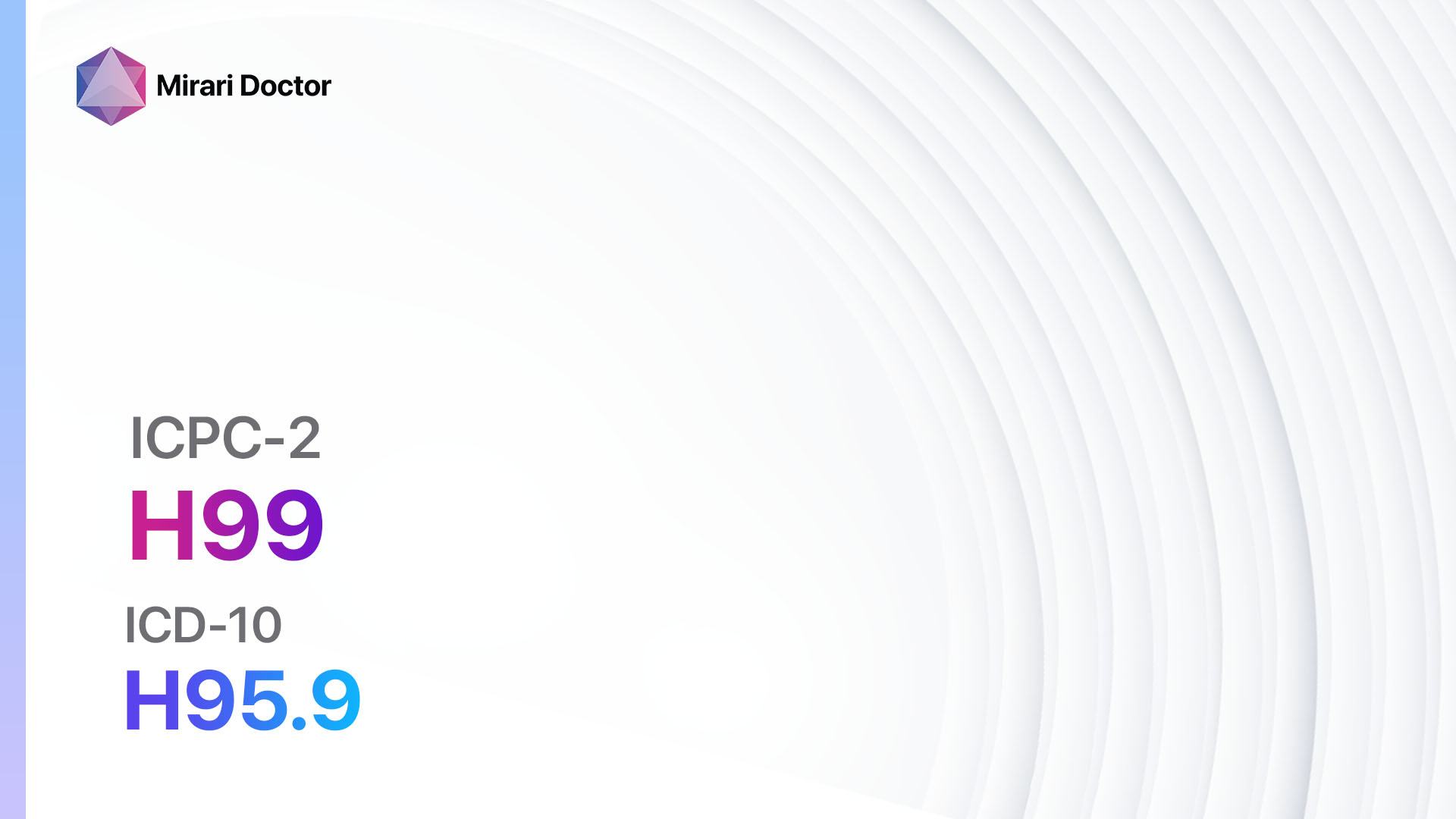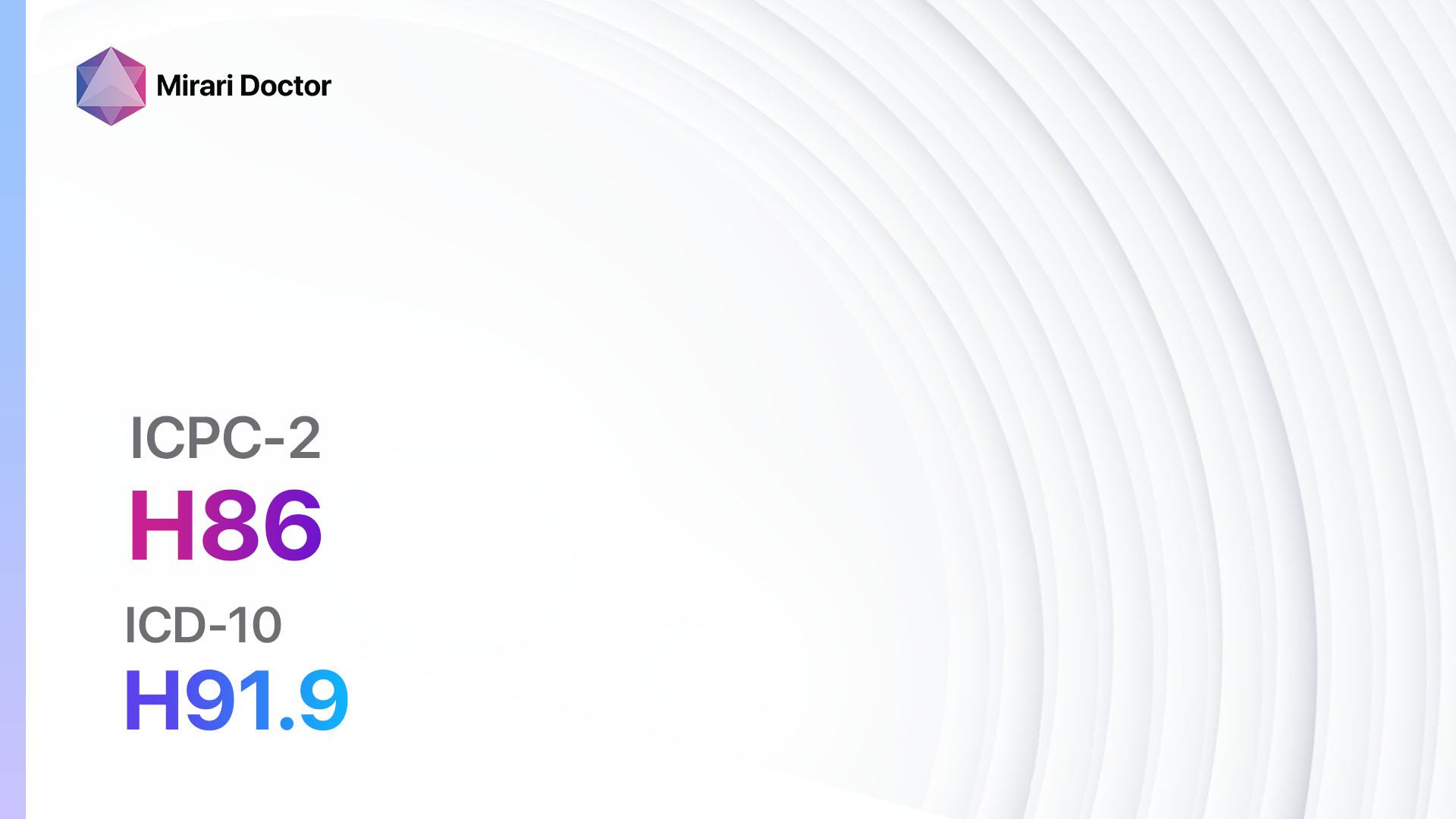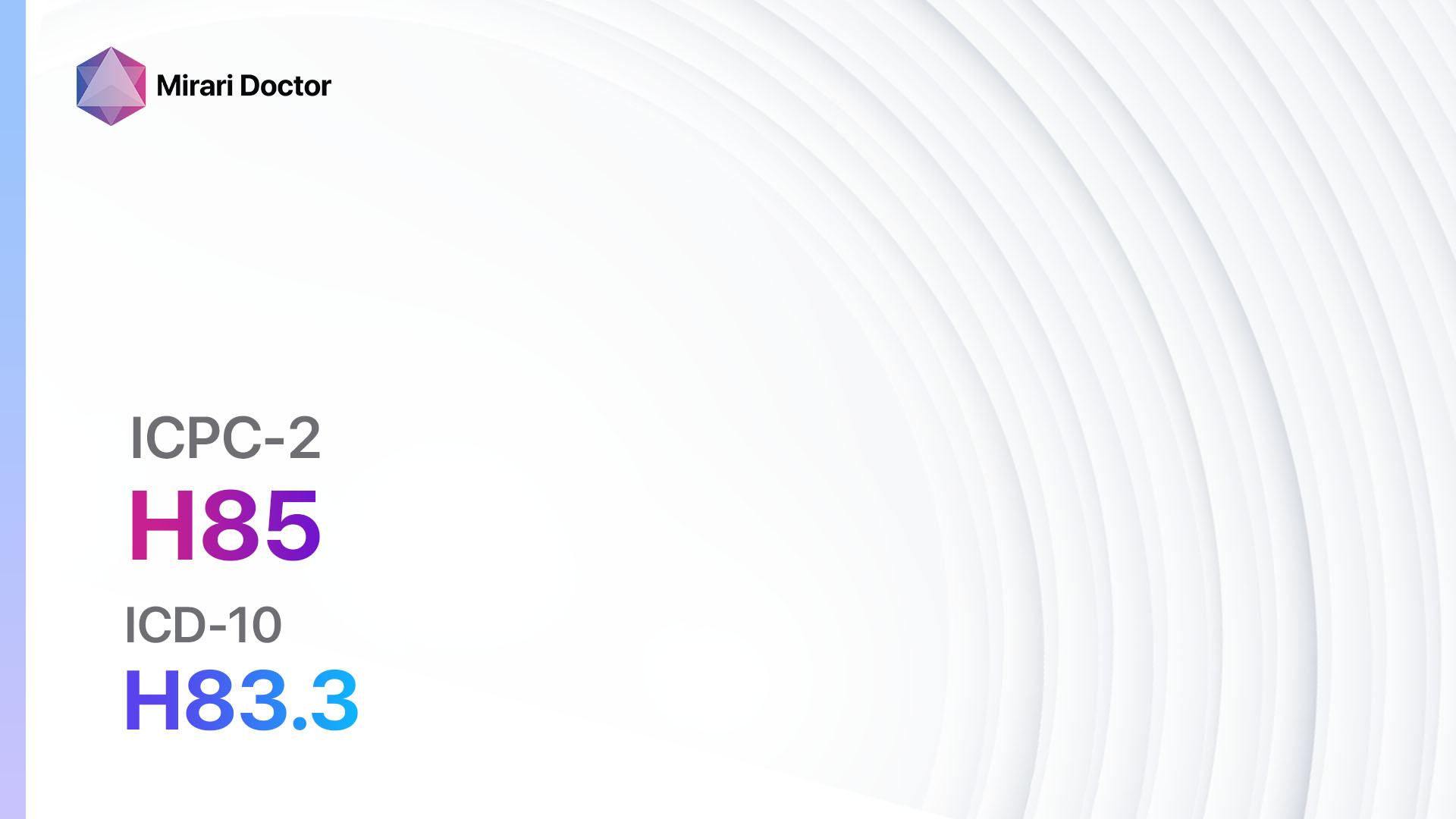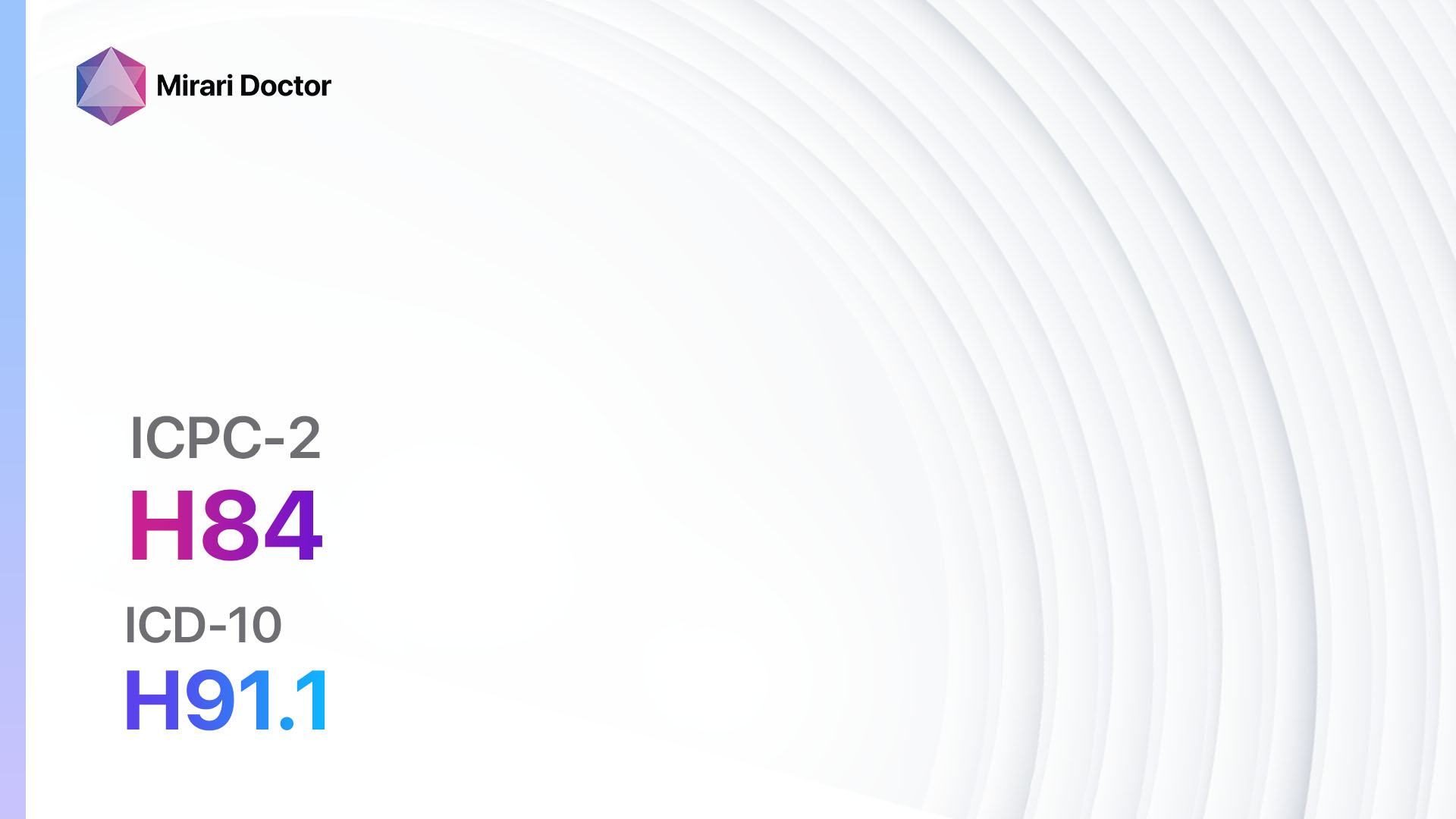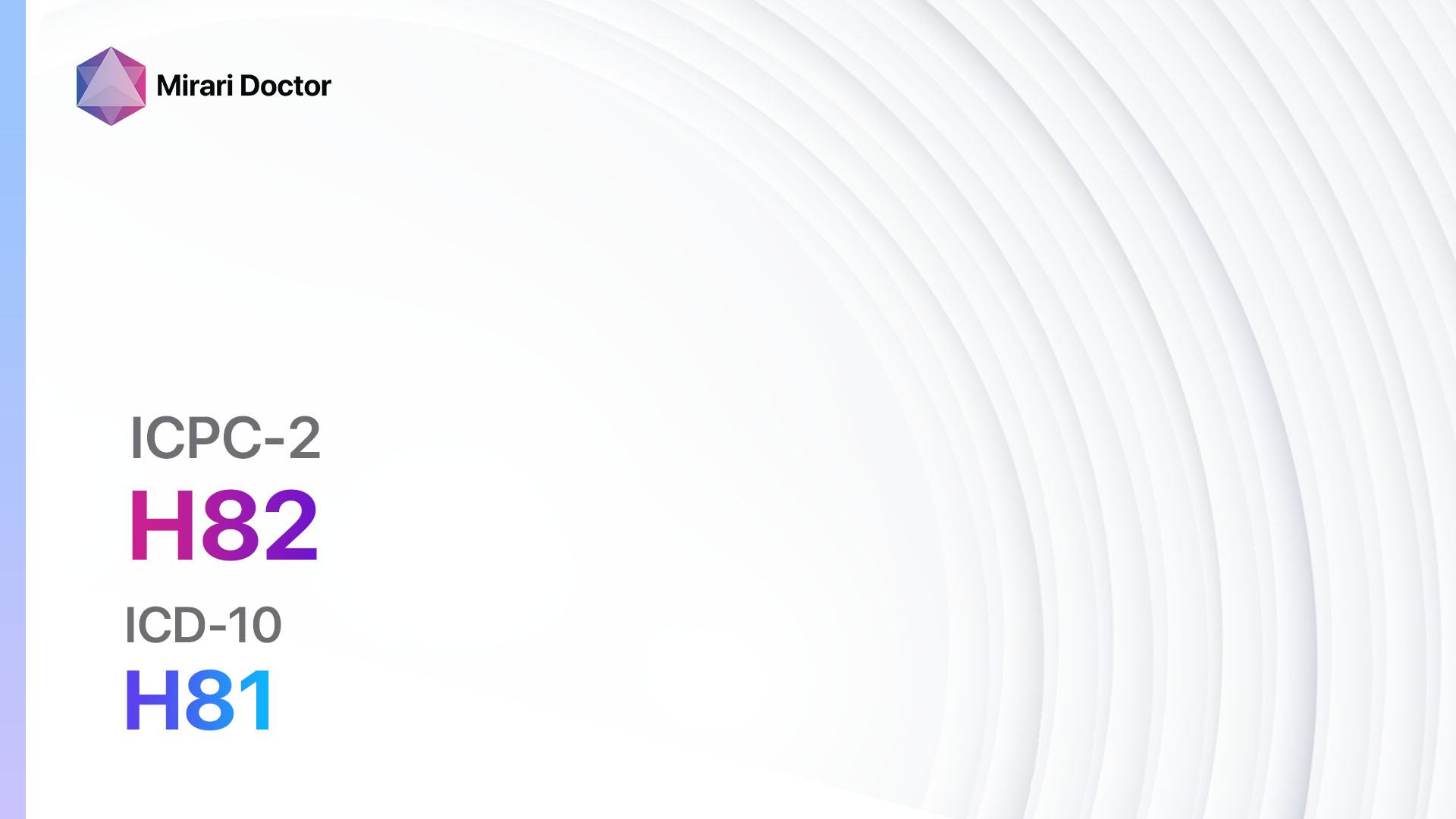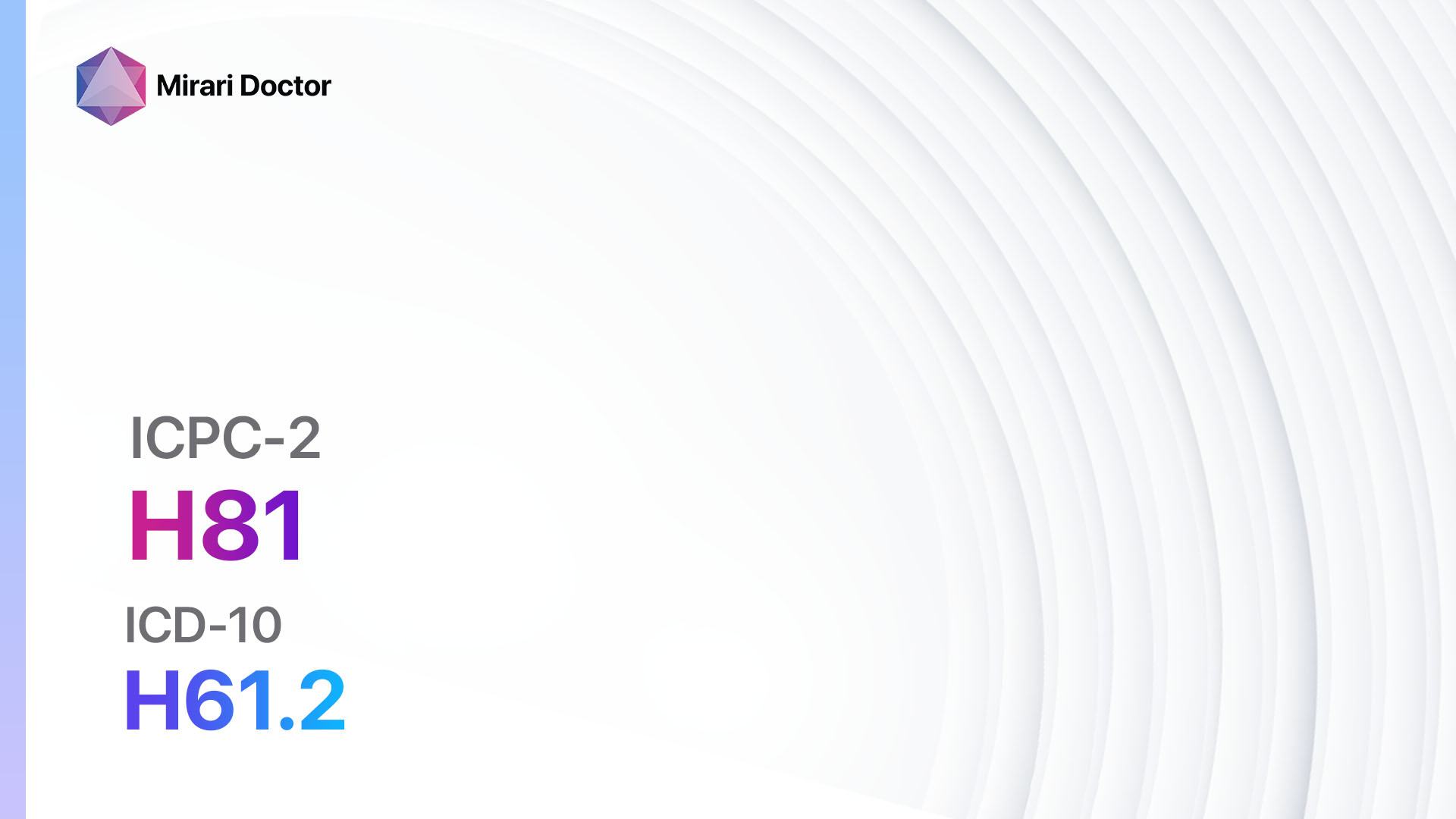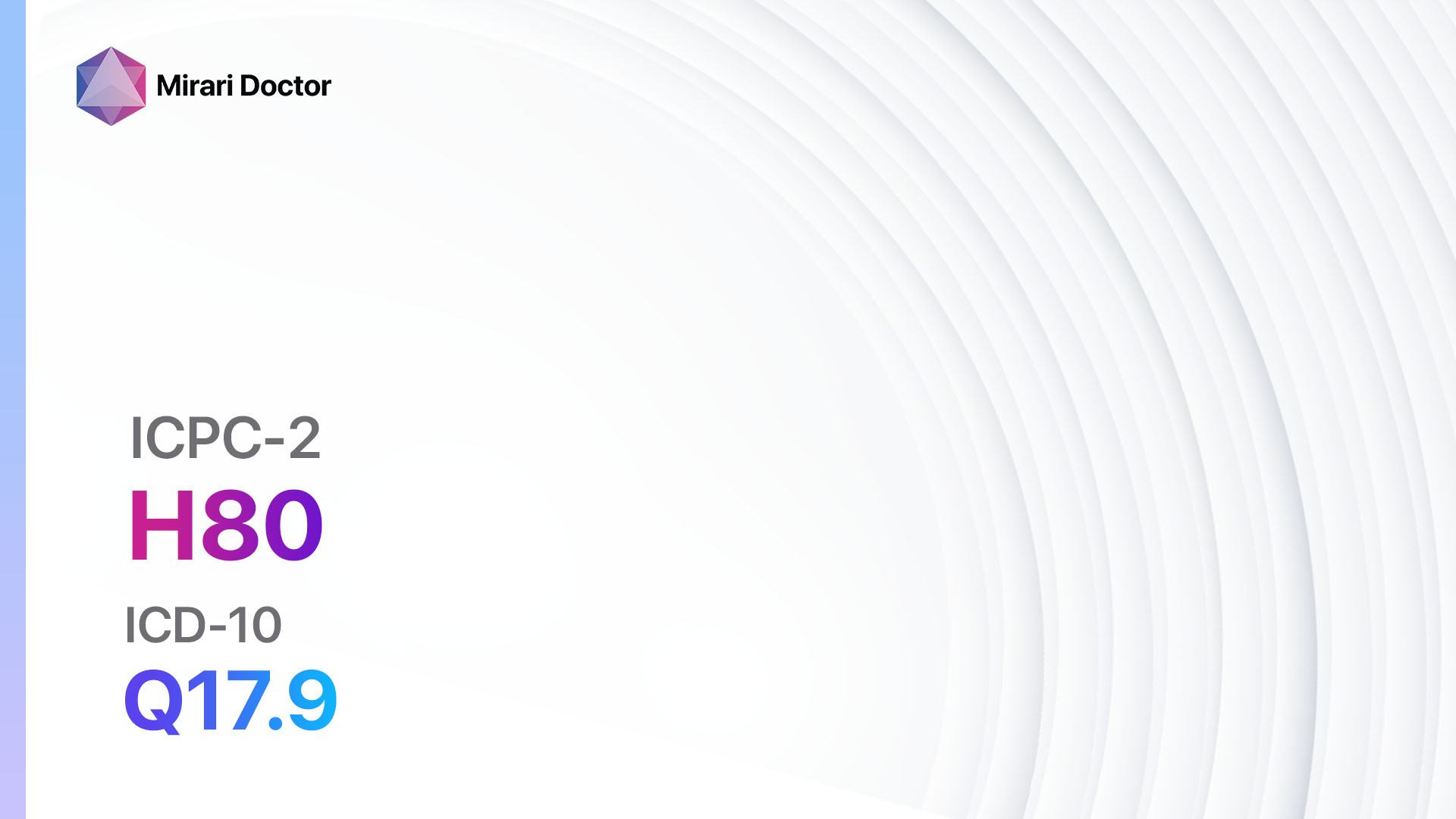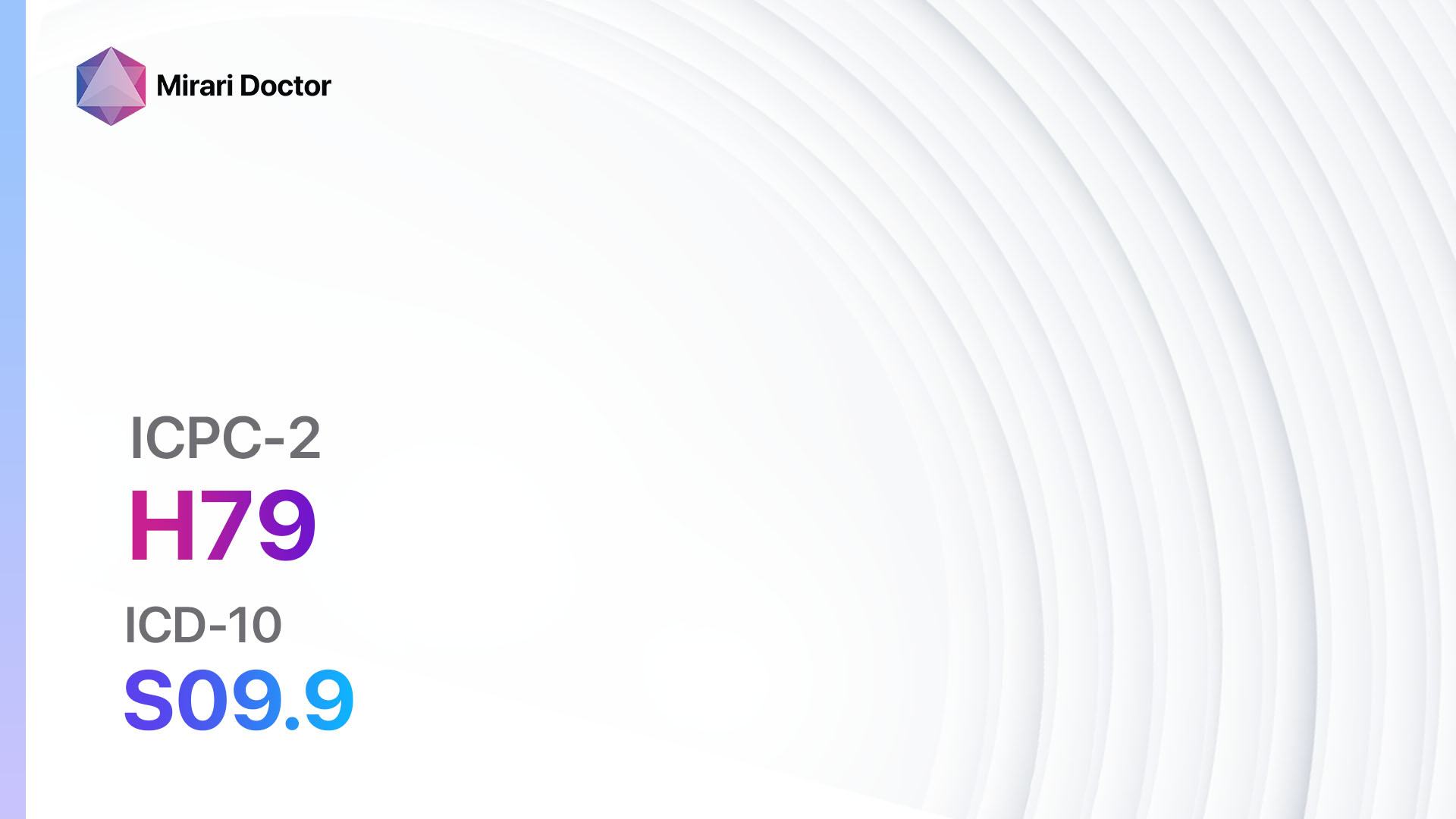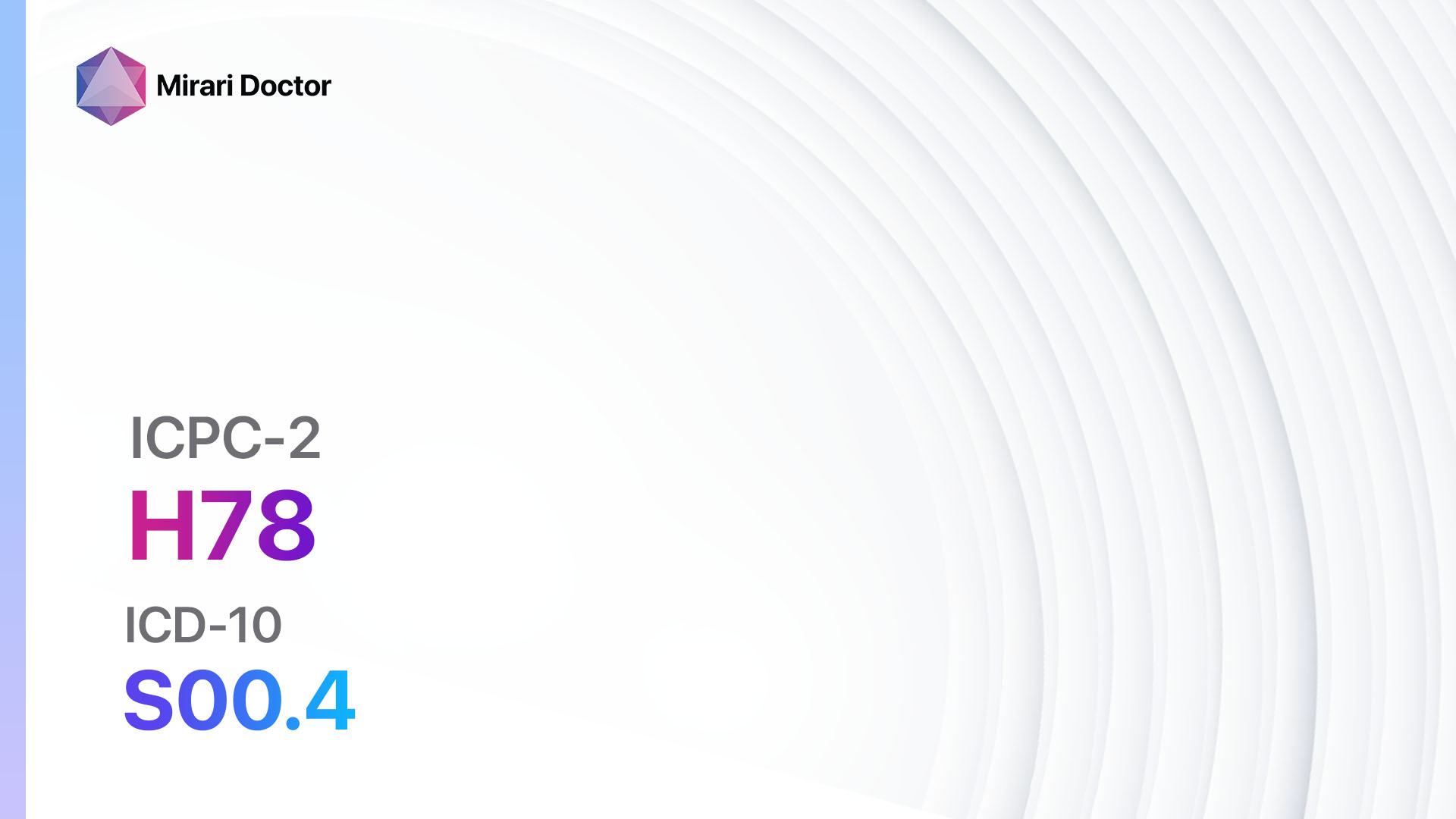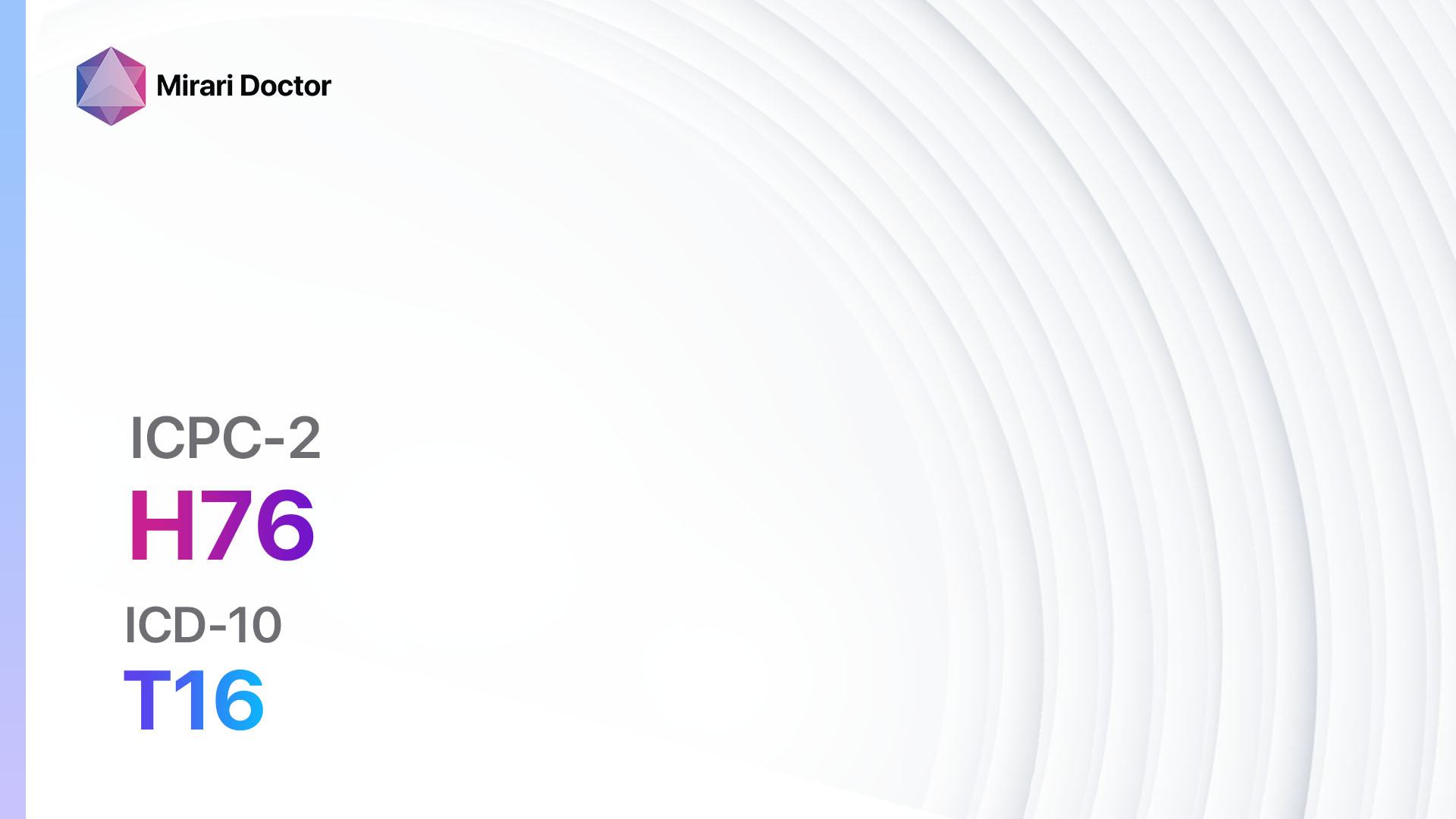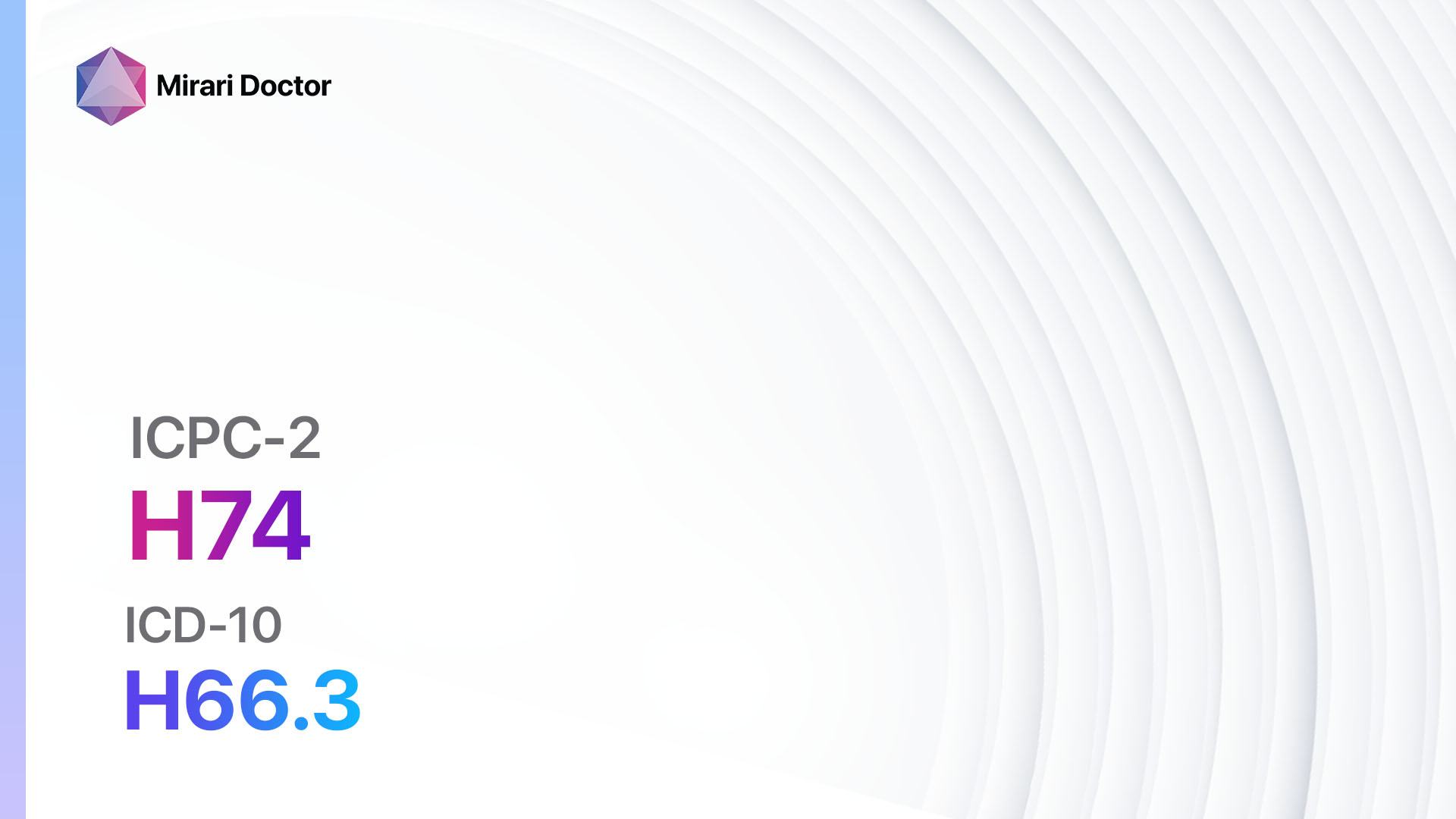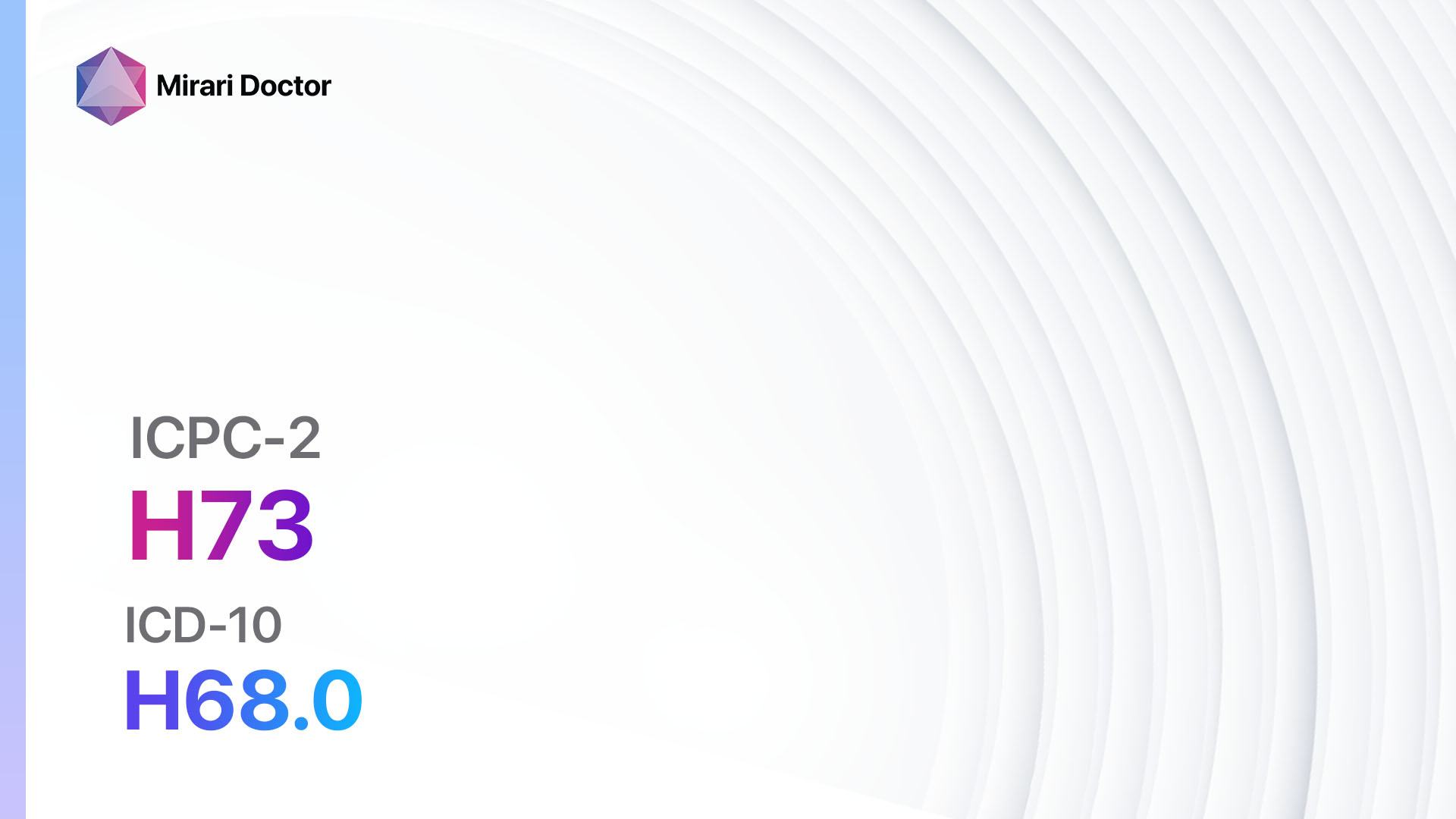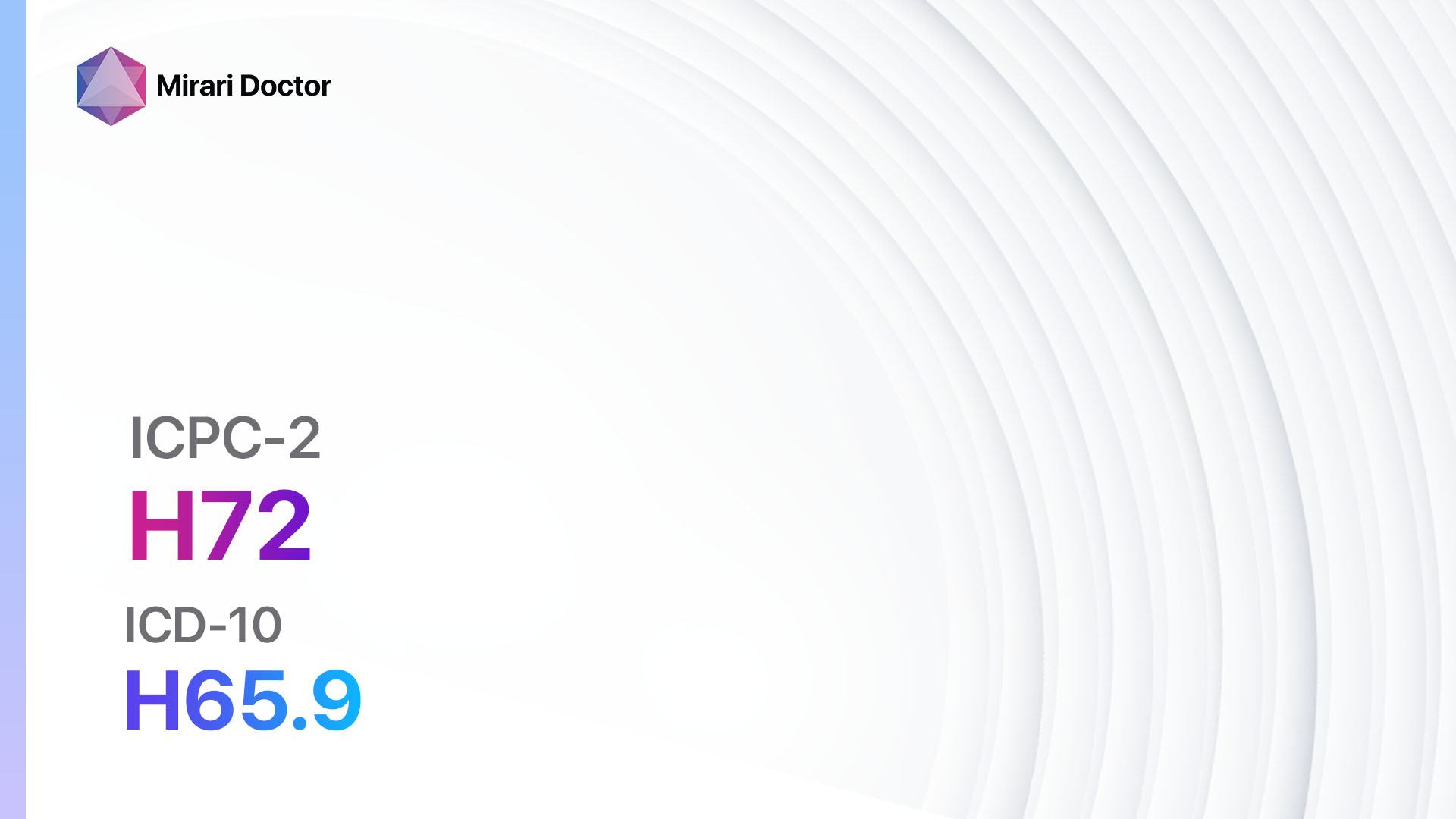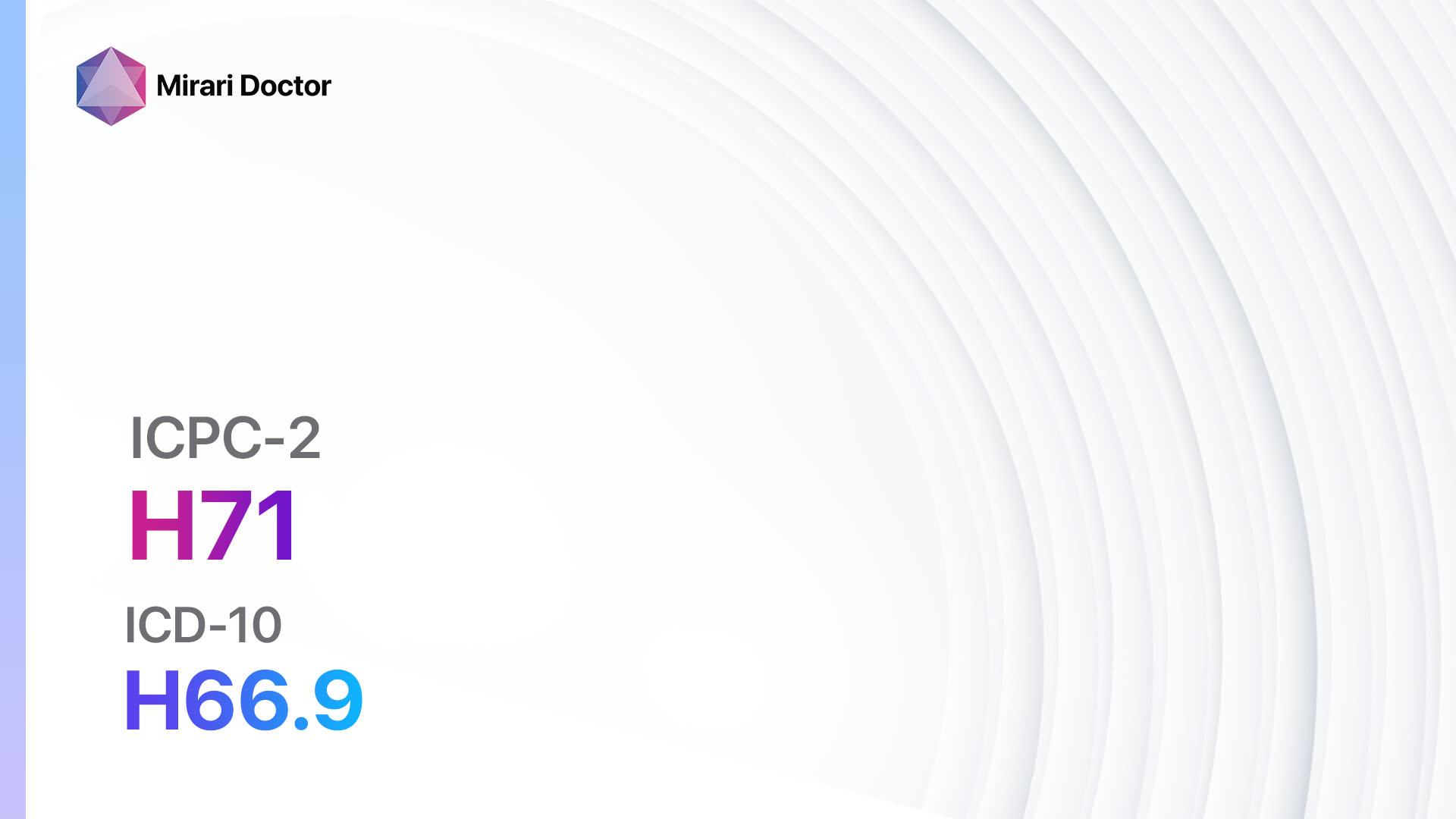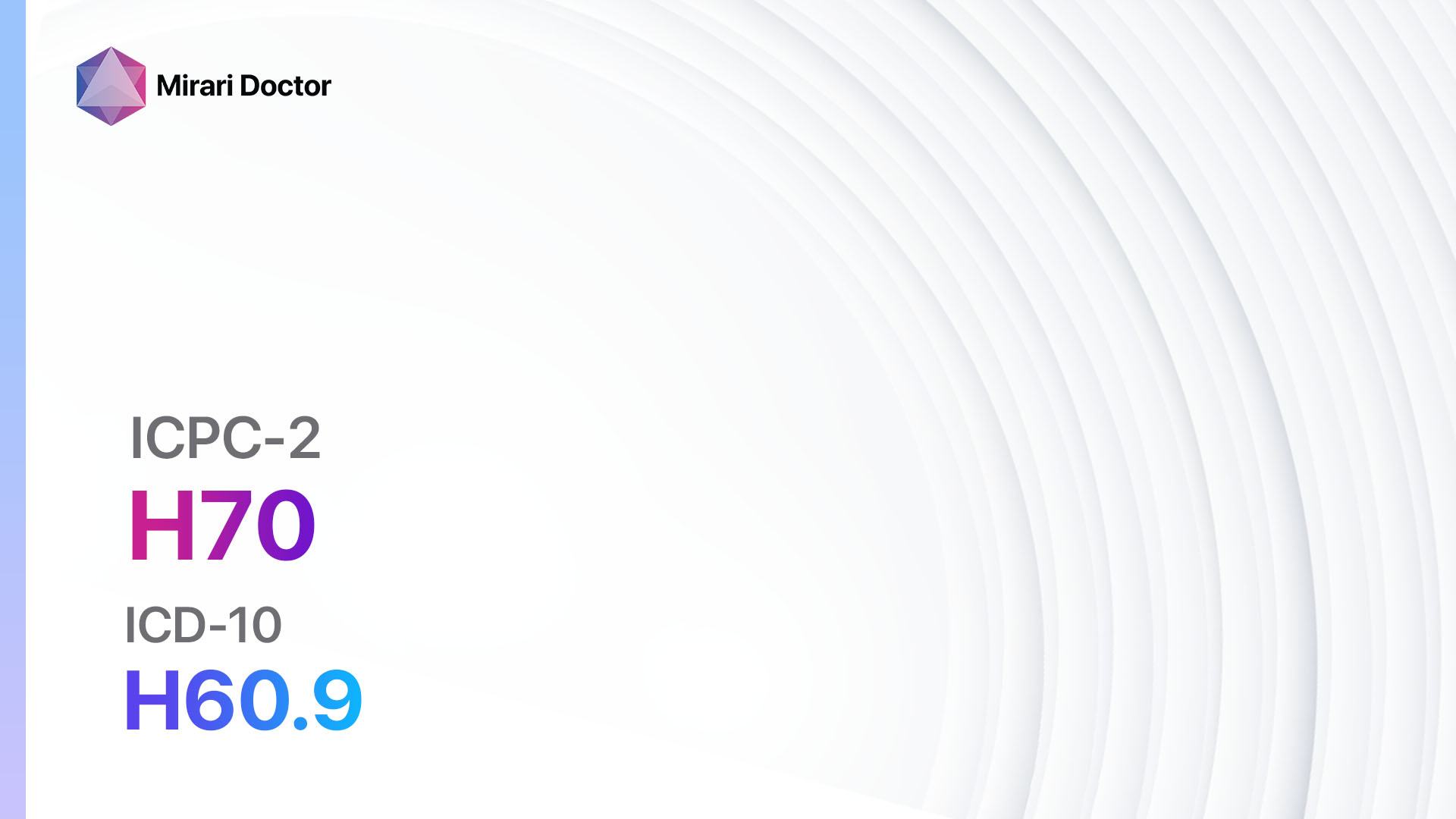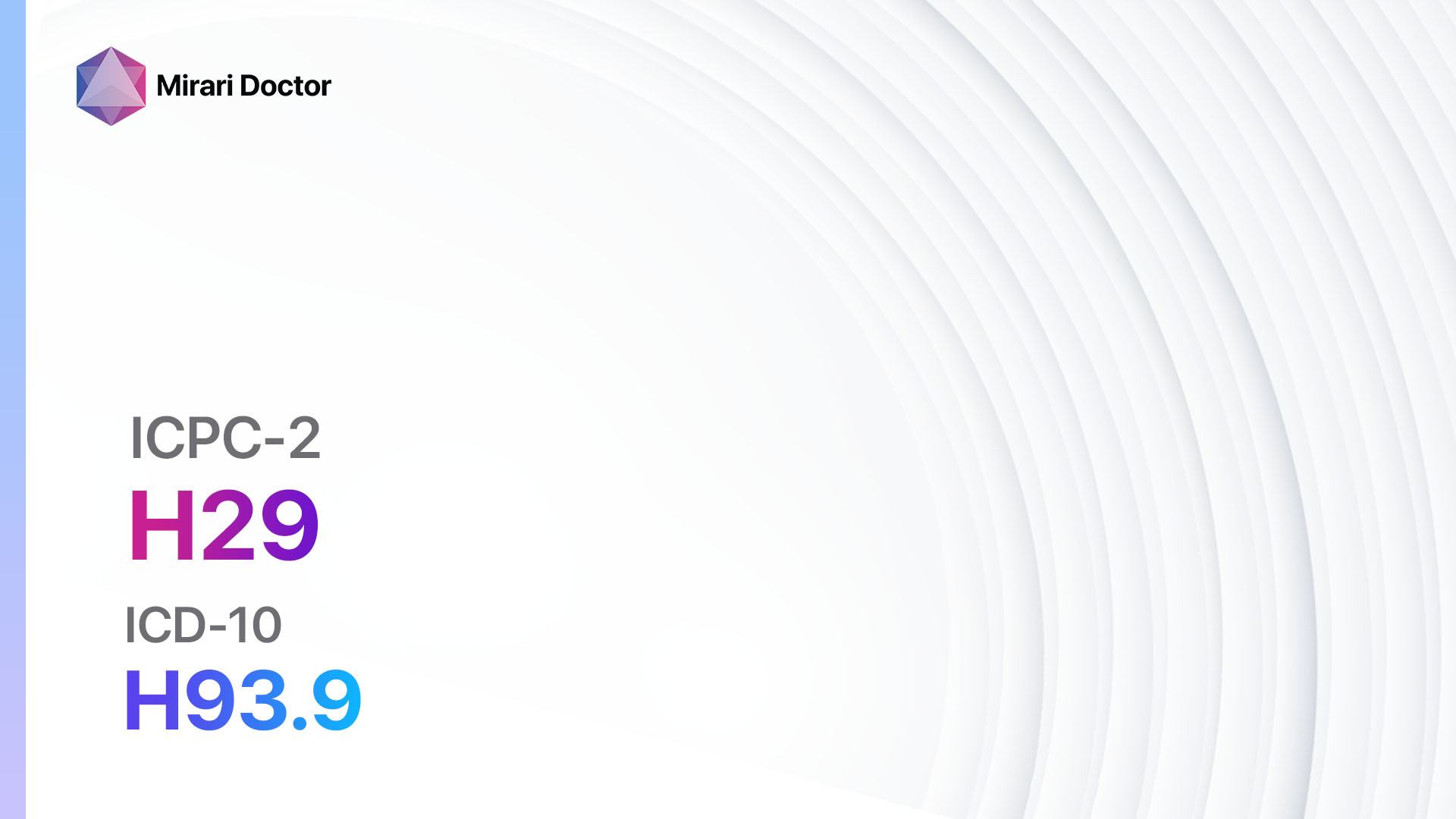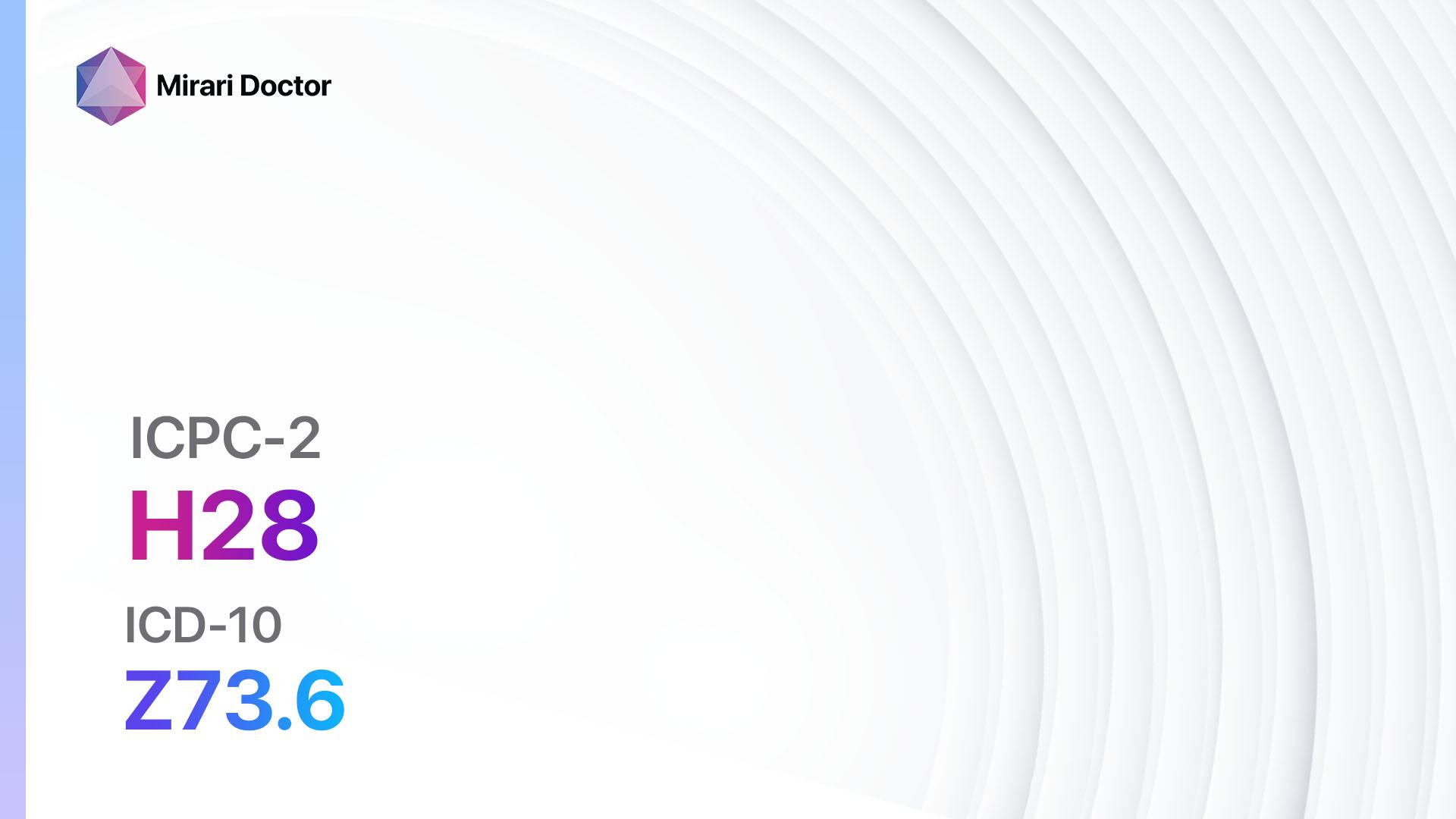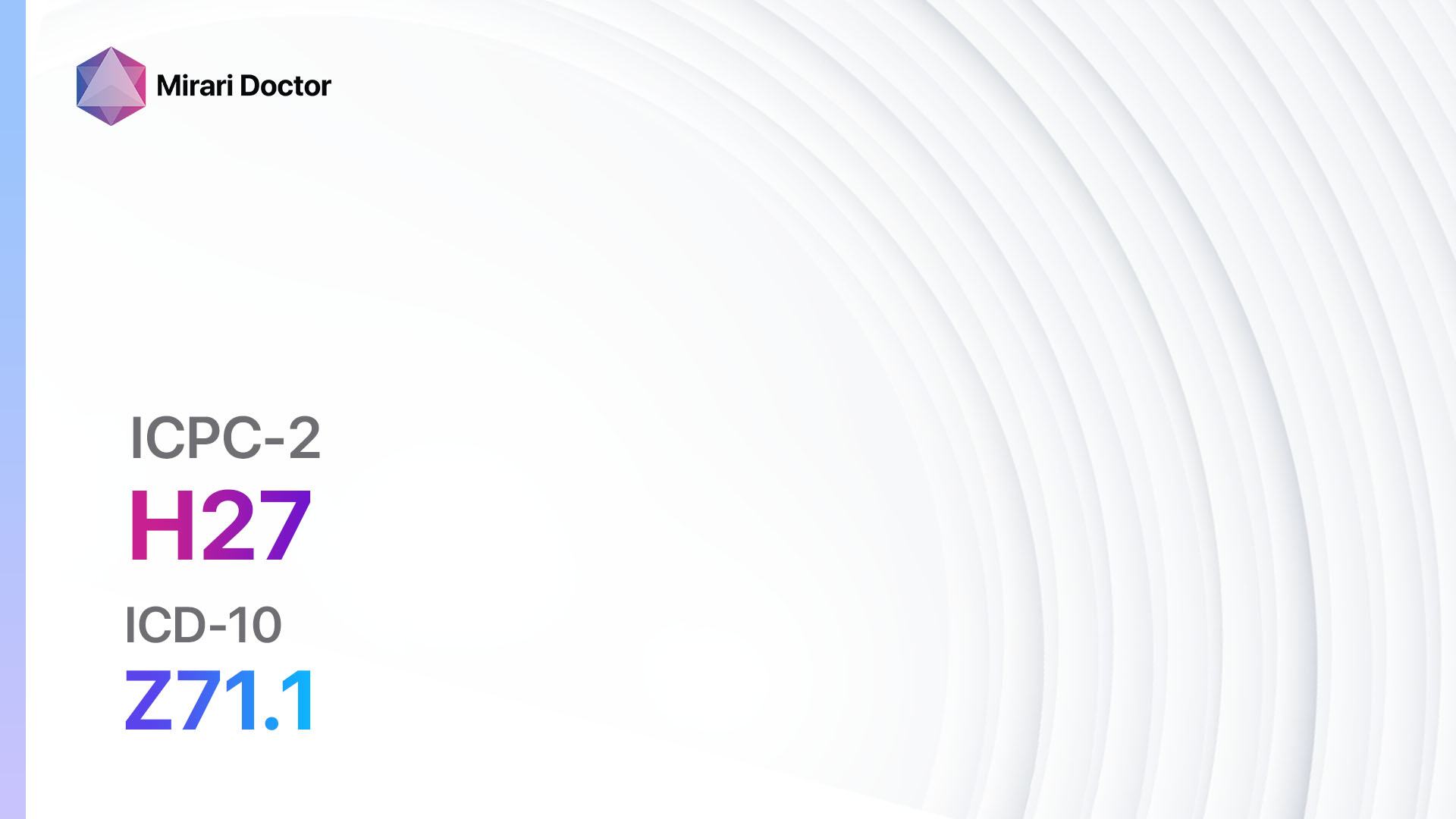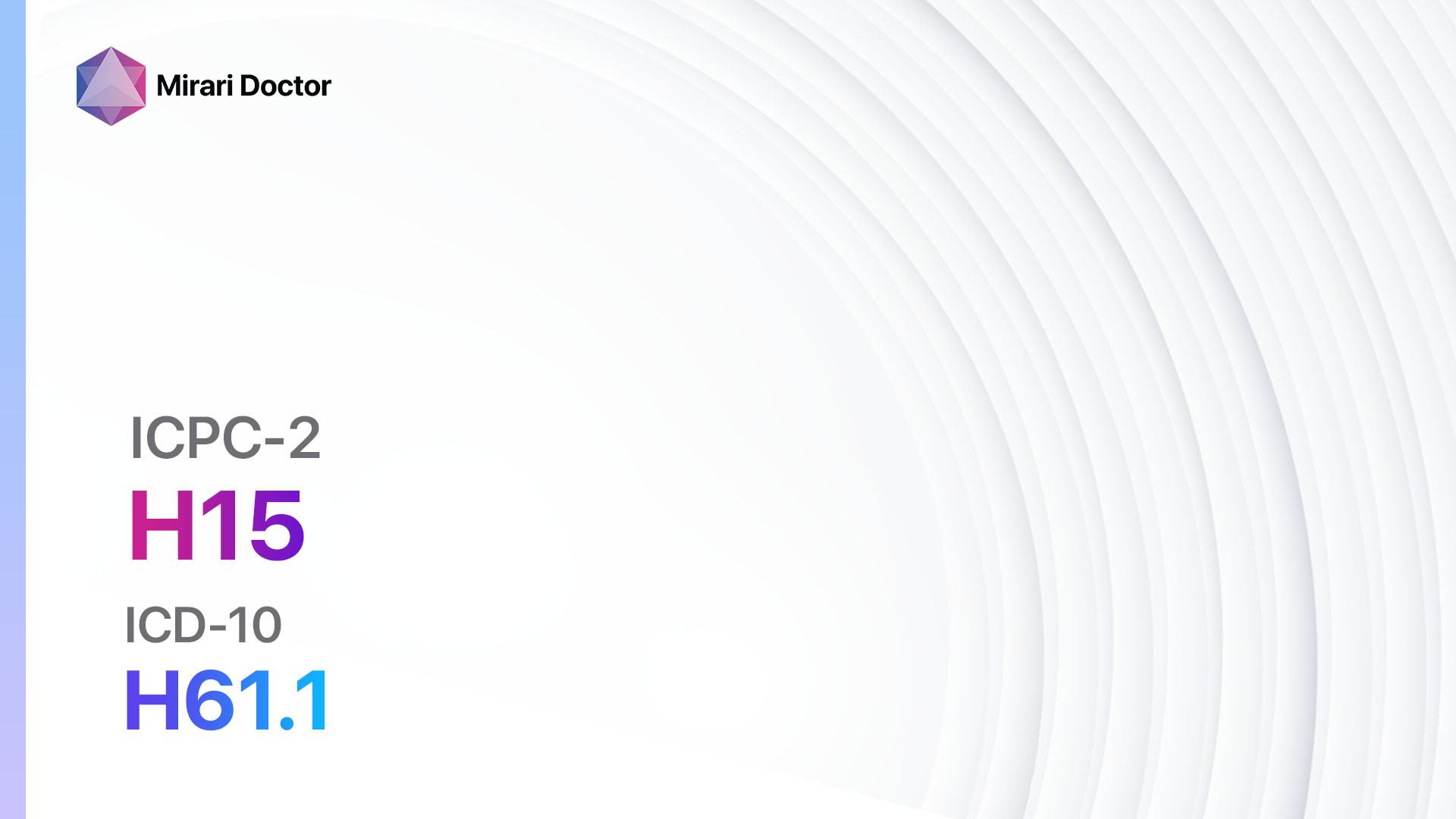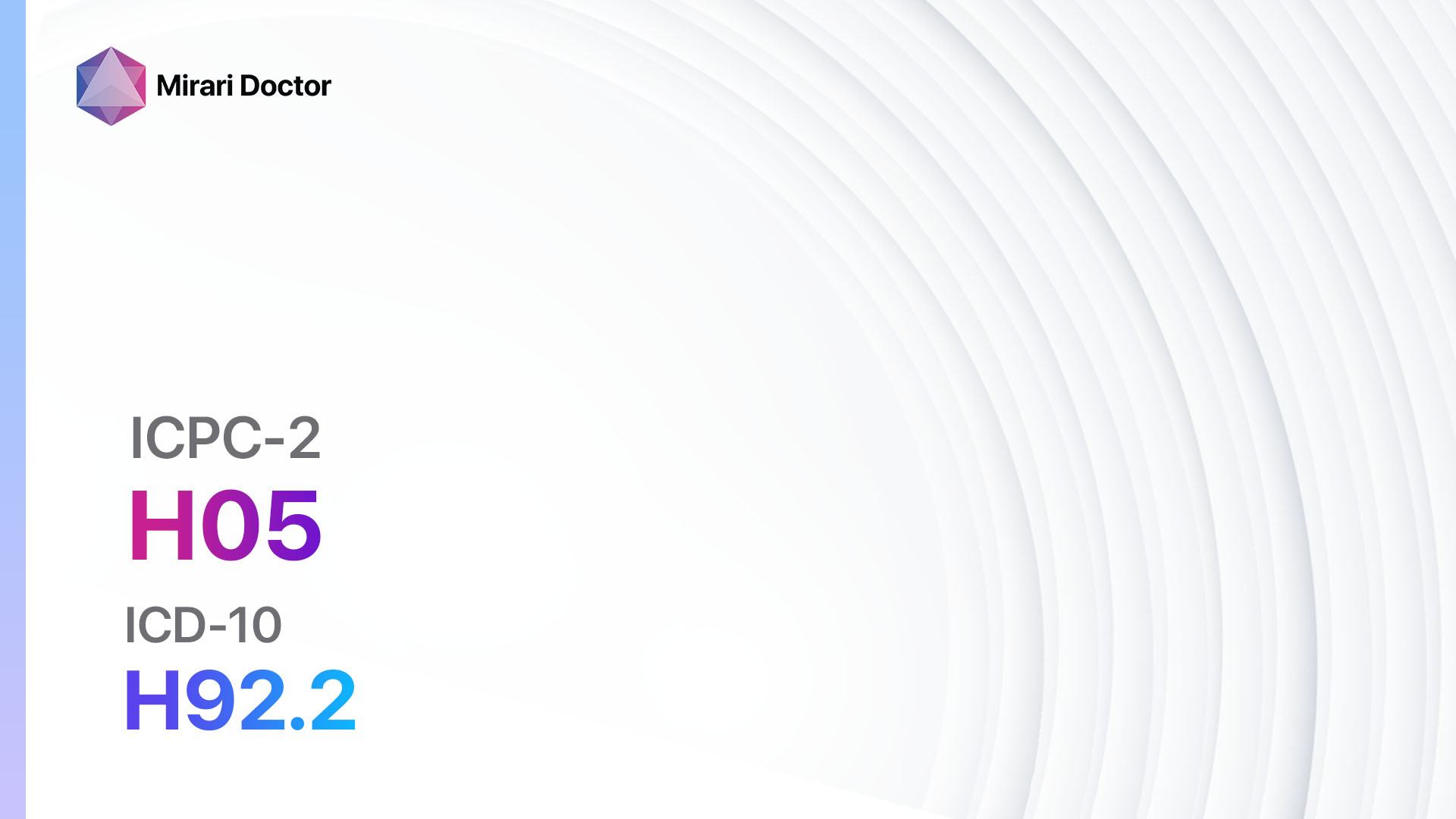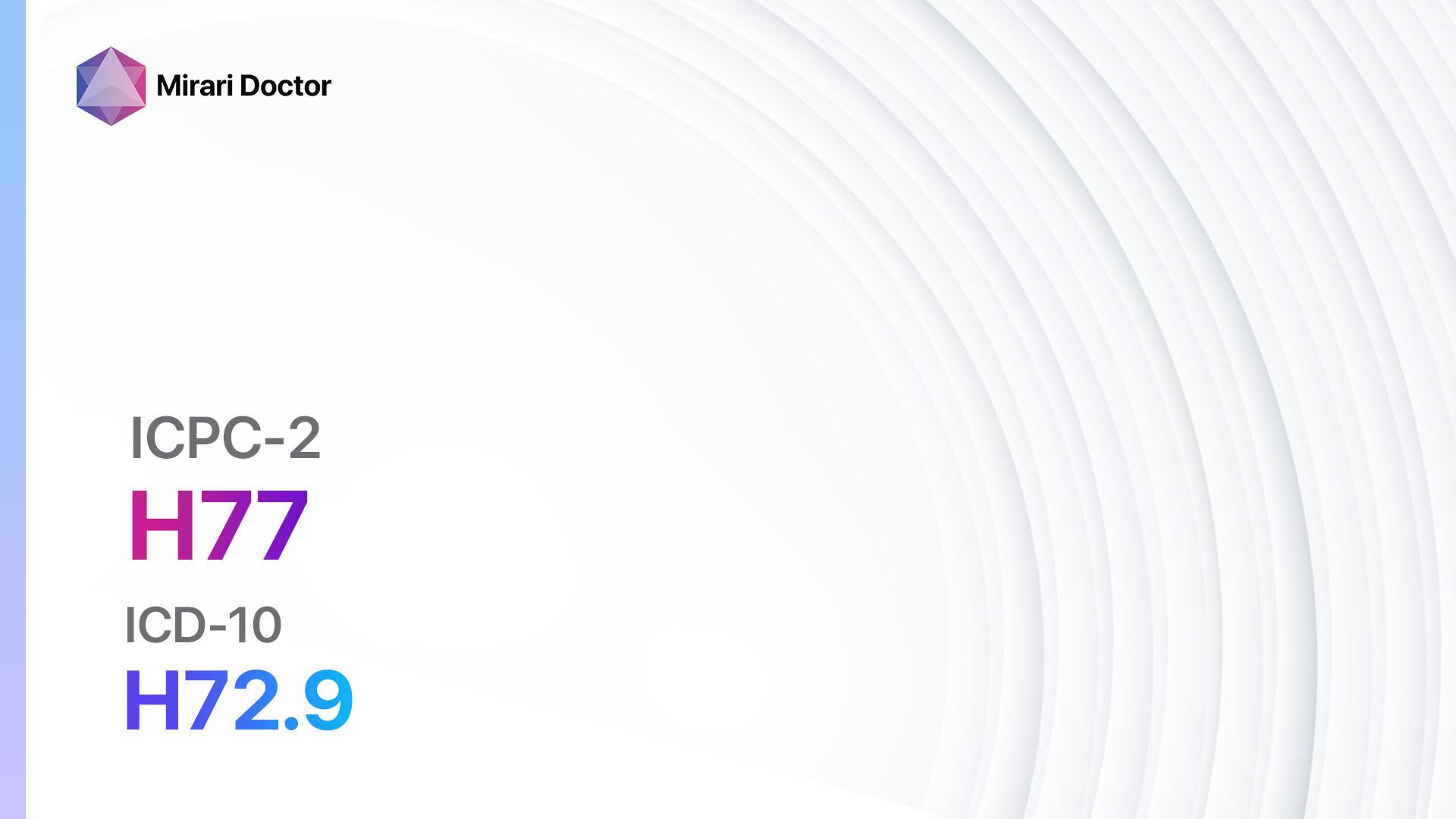
Introduction
Perforation of the ear drum, also known as a tympanic membrane perforation, is a condition where there is a hole or tear in the thin tissue that separates the outer ear from the middle ear[1]. This condition can result in hearing loss, ear pain, and increased susceptibility to ear infections[2]. The aim of this guide is to provide a comprehensive overview of the symptoms, causes, diagnostic steps, possible interventions, and patient education related to perforation ear drum.
Codes
- ICPC-2 Code: H77 Perforation ear drum[3]
- ICD-10 Code: H72.9 Unspecified perforation of tympanic membrane[4]
Symptoms
- Ear pain: Patients may experience sharp or dull pain in the affected ear[5].
- Hearing loss: A decrease in hearing ability may occur, ranging from mild to severe[6].
- Tinnitus: Some patients may experience a ringing or buzzing sound in the affected ear[7].
- Ear discharge: Fluid or pus may drain from the ear[8].
- Vertigo: A spinning sensation or dizziness may be present[9].
Causes
- Middle ear infections: Chronic or severe infections can lead to the formation of a perforation[10].
- Trauma: Injury to the ear, such as a direct blow or insertion of a foreign object, can cause a tear in the ear drum.
- Barotrauma: Rapid changes in air pressure, such as during air travel or scuba diving, can result in a perforation.
- Acoustic trauma: Exposure to loud noises over a prolonged period of time can damage the ear drum.
- Chronic otitis media: Long-standing inflammation of the middle ear can weaken the ear drum and lead to a perforation.
Diagnostic Steps
Medical History
- Gather information about the patient’s symptoms, including the duration and severity of ear pain, hearing loss, and any associated symptoms.
- Inquire about any recent trauma or exposure to loud noises.
- Ask about the patient’s medical history, including previous ear infections or surgeries.
Physical Examination
- Inspect the external ear for any signs of trauma or infection.
- Use an otoscope to examine the ear canal and tympanic membrane for the presence of a perforation.
- Assess the patient’s hearing ability using a tuning fork or audiometry.
Laboratory Tests
- No specific laboratory tests are required for the diagnosis of a perforation ear drum.
Diagnostic Imaging
- Imaging studies, such as a CT scan or MRI, may be ordered to assess the extent of damage or to rule out other underlying conditions.
Other Tests
- Tympanometry: This test measures the movement of the ear drum in response to changes in air pressure, helping to evaluate the function of the middle ear.
Follow-up and Patient Education
- Advise the patient to avoid inserting any objects into the ear canal.
- Educate the patient about the importance of keeping the ear dry to prevent infection.
- Schedule a follow-up appointment to monitor the healing process and assess any changes in symptoms.
Possible Interventions
Traditional Interventions
Medications:
Top 5 drugs for Perforation ear drum:
- Antibiotic ear drops (e.g., Ciprofloxacin, Ofloxacin):
- Cost: $10-$30 per bottle.
- Contraindications: Hypersensitivity to the medication.
- Side effects: Local irritation, itching.
- Severe side effects: Allergic reactions, hearing loss.
- Drug interactions: None reported.
- Warning: Use as directed and complete the full course of treatment.
- Pain relievers (e.g., Acetaminophen, Ibuprofen):
- Cost: $5-$15 per bottle.
- Contraindications: Allergy to the medication, history of stomach ulcers.
- Side effects: Upset stomach, dizziness.
- Severe side effects: Liver damage, gastrointestinal bleeding.
- Drug interactions: Warfarin, other nonsteroidal anti-inflammatory drugs (NSAIDs).
- Warning: Do not exceed the recommended dosage.
- Steroid ear drops (e.g., Dexamethasone, Hydrocortisone):
- Cost: $10-$30 per bottle.
- Contraindications: Fungal or viral ear infections.
- Side effects: Local irritation, burning sensation.
- Severe side effects: Allergic reactions, hearing loss.
- Drug interactions: None reported.
- Warning: Use as directed and do not use for prolonged periods.
- Decongestant nasal sprays (e.g., Oxymetazoline, Phenylephrine):
- Cost: $5-$15 per bottle.
- Contraindications: Hypersensitivity to the medication, uncontrolled high blood pressure.
- Side effects: Nasal dryness, rebound congestion.
- Severe side effects: Increased blood pressure, irregular heartbeat.
- Drug interactions: Monoamine oxidase inhibitors (MAOIs), tricyclic antidepressants.
- Warning: Limit use to a maximum of 3-5 days to avoid rebound congestion.
- Antihistamines (e.g., Loratadine, Cetirizine):
- Cost: $5-$15 per bottle.
- Contraindications: Hypersensitivity to the medication, narrow-angle glaucoma.
- Side effects: Drowsiness, dry mouth.
- Severe side effects: Severe allergic reactions, difficulty urinating.
- Drug interactions: Sedatives, tranquilizers.
- Warning: Avoid activities requiring mental alertness until the effects are known.
Alternative Drugs:
- Ear drops with silver nanoparticles: Some studies suggest that silver nanoparticles may have antimicrobial properties and aid in wound healing.
- Hyaluronic acid ear drops: Hyaluronic acid can help promote tissue regeneration and reduce inflammation.
- Vitamin E oil: Topical application of vitamin E oil may help with wound healing.
Surgical Procedures:
- Tympanoplasty: This surgical procedure involves repairing the perforated ear drum using a graft of tissue from the patient’s own body or a synthetic material. Cost: $5,000-$10,000.
- Myringoplasty: Similar to tympanoplasty, myringoplasty is a procedure that repairs the perforated ear drum using a graft. Cost: $5,000-$10,000.
Alternative Interventions
- Acupuncture: May help reduce pain and promote healing. Cost: $60-$120 per session.
- Herbal remedies: Certain herbs, such as mullein and calendula, have been traditionally used to treat ear infections and promote healing. Cost: Varies depending on the specific herb and preparation.
- Homeopathic remedies: Some homeopathic remedies, such as Pulsatilla and Silicea, are believed to aid in the healing of perforated ear drums. Cost: Varies depending on the specific remedy and brand.
- Warm compresses: Applying warm compresses to the affected ear may help alleviate pain and promote healing. Cost: Minimal.
- Salt water gargles: Gargling with warm salt water can help reduce inflammation and prevent infection. Cost: Minimal.
Lifestyle Interventions
- Avoiding exposure to loud noises: Limiting exposure to loud noises can help prevent further damage to the ear drum. Cost: None.
- Keeping the ear dry: Avoiding water exposure in the affected ear can help prevent infection and promote healing. Cost: None.
- Quitting smoking: Smoking can impair the healing process and increase the risk of complications. Cost: None.
- Maintaining good hygiene: Regularly cleaning the outer ear and avoiding the use of cotton swabs can help prevent further damage. Cost: Minimal.
- Using ear protection: Wearing ear plugs or earmuffs in noisy environments can help protect the ears. Cost: Varies depending on the type of ear protection.
It is important to note that the cost ranges provided are approximate and may vary depending on the location and availability of the interventions.
Mirari Cold Plasma Alternative Intervention
Understanding Mirari Cold Plasma
- Safe and Non-Invasive Treatment: Mirari Cold Plasma is a safe and non-invasive treatment option for various skin conditions. It does not require incisions, minimizing the risk of scarring, bleeding, or tissue damage.
- Efficient Extraction of Foreign Bodies: Mirari Cold Plasma facilitates the removal of foreign bodies from the skin by degrading and dissociating organic matter, allowing easier access and extraction.
- Pain Reduction and Comfort: Mirari Cold Plasma has a local analgesic effect, providing pain relief during the treatment, making it more comfortable for the patient.
- Reduced Risk of Infection: Mirari Cold Plasma has antimicrobial properties, effectively killing bacteria and reducing the risk of infection.
- Accelerated Healing and Minimal Scarring: Mirari Cold Plasma stimulates wound healing and tissue regeneration, reducing healing time and minimizing the formation of scars.
Mirari Cold Plasma Prescription
Video instructions for using Mirari Cold Plasma Device – H77 Perforation ear drum (ICD-10:H72.9)
| Mild | Moderate | Severe |
| Mode setting: 1 (Infection) Location: 0 (Localized) Morning: 15 minutes, Evening: 15 minutes | Mode setting: 1 (Infection) Location: 0 (Localized) Morning: 30 minutes, Lunch: 30 minutes, Evening: 30 minutes | Mode setting: 1 (Infection) Location: 0 (Localized) Morning: 30 minutes, Lunch: 30 minutes, Evening: 30 minutes |
| Mode setting: 2 (Wound Healing) Location: 0 (Localized) Morning: 15 minutes, Evening: 15 minutes | Mode setting: 2 (Wound Healing) Location: 0 (Localized) Morning: 30 minutes, Lunch: 30 minutes, Evening: 30 minutes | Mode setting: 2 (Wound Healing) Location: 0 (Localized) Morning: 30 minutes, Lunch: 30 minutes, Evening: 30 minutes |
| Mode setting: 3 (Antiviral Therapy) Location: 0 (Localized) Morning: 15 minutes, Evening: 15 minutes | Mode setting: 3 (Antiviral Therapy) Location: 0 (Localized) Morning: 30 minutes, Lunch: 30 minutes, Evening: 30 minutes | Mode setting: 3 (Antiviral Therapy) Location: 0 (Localized) Morning: 30 minutes, Lunch: 30 minutes, Evening: 30 minutes |
| Total Morning: 45 minutes approx. $7.50 USD, Evening: 45 minutes approx. $7.50 USD | Total Morning: 90 minutes approx. $15 USD, Lunch: 90 minutes approx. $15 USD, Evening: 90 minutes approx. $15 USD, | Total Morning: 90 minutes approx. $15 USD, Lunch: 90 minutes approx. $15 USD, Evening: 90 minutes approx. $15 USD, |
| Usual treatment for 7-60 days approx. $105 USD – $900 USD | Usual treatment for 6-8 weeks approx. $1,890USD – $2,520 USD | Usual treatment for 3-6 months approx. $4,050 USD – $8,100 USD |
 |
|
Use the Mirari Cold Plasma device to treat Perforation ear drum effectively.
WARNING: MIRARI COLD PLASMA IS DESIGNED FOR THE HUMAN BODY WITHOUT ANY ARTIFICIAL OR THIRD PARTY PRODUCTS. USE OF OTHER PRODUCTS IN COMBINATION WITH MIRARI COLD PLASMA MAY CAUSE UNPREDICTABLE EFFECTS, HARM OR INJURY. PLEASE CONSULT A MEDICAL PROFESSIONAL BEFORE COMBINING ANY OTHER PRODUCTS WITH USE OF MIRARI.
Step 1: Cleanse the Skin
- Start by cleaning the affected area of the skin with a gentle cleanser or mild soap and water. Gently pat the area dry with a clean towel.
Step 2: Prepare the Mirari Cold Plasma device
- Ensure that the Mirari Cold Plasma device is fully charged or has fresh batteries as per the manufacturer’s instructions. Make sure the device is clean and in good working condition.
- Switch on the Mirari device using the power button or by following the specific instructions provided with the device.
- Some Mirari devices may have adjustable settings for intensity or treatment duration. Follow the manufacturer’s instructions to select the appropriate settings based on your needs and the recommended guidelines.
Step 3: Apply the Device
- Place the Mirari device in direct contact with the affected area of the skin. Gently glide or hold the device over the skin surface, ensuring even coverage of the area experiencing.
- Slowly move the Mirari device in a circular motion or follow a specific pattern as indicated in the user manual. This helps ensure thorough treatment coverage.
Step 4: Monitor and Assess:
- Keep track of your progress and evaluate the effectiveness of the Mirari device in managing your Perforation ear drum. If you have any concerns or notice any adverse reactions, consult with your health care professional.
Note
This guide is for informational purposes only and should not replace the advice of a medical professional. Always consult with your healthcare provider or a qualified medical professional for personal advice, diagnosis, or treatment. Do not solely rely on the information presented here for decisions about your health. Use of this information is at your own risk. The authors of this guide, nor any associated entities or platforms, are not responsible for any potential adverse effects or outcomes based on the content.
Mirari Cold Plasma System Disclaimer
- Purpose: The Mirari Cold Plasma System is a Class 2 medical device designed for use by trained healthcare professionals. It is registered for use in Thailand and Vietnam. It is not intended for use outside of these locations.
- Informational Use: The content and information provided with the device are for educational and informational purposes only. They are not a substitute for professional medical advice or care.
- Variable Outcomes: While the device is approved for specific uses, individual outcomes can differ. We do not assert or guarantee specific medical outcomes.
- Consultation: Prior to utilizing the device or making decisions based on its content, it is essential to consult with a Certified Mirari Tele-Therapist and your medical healthcare provider regarding specific protocols.
- Liability: By using this device, users are acknowledging and accepting all potential risks. Neither the manufacturer nor the distributor will be held accountable for any adverse reactions, injuries, or damages stemming from its use.
- Geographical Availability: This device has received approval for designated purposes by the Thai and Vietnam FDA. As of now, outside of Thailand and Vietnam, the Mirari Cold Plasma System is not available for purchase or use.
References
- AAPC. (n.d.). ICD-10-CM Code for Perforation of tympanic membrane H72 – AAPC. Retrieved from//www.aapc.com/codes/icd-10-codes/H72
- Patient.info. (n.d.). Perforated Eardrum: Causes, Symptoms, and Treatment – Patient.info. Retrieved from//patient.info/ears-nose-throat-mouth/hearing-problems/perforated-eardrum
- PH3C. (n.d.). ICPC-1 mapping ICPC-2.xlsx – PH3C. Retrieved from//www.ph3c.org/PH3C/docs/27/000460/0000852.pdf
- ICD10data.com. (2024). 2024 ICD-10-CM Codes H72*: Perforation of tympanic membrane. Retrieved from//www.icd10data.com/ICD10CM/Codes/H60-H95/H65-H75/H72-
- MSD Manuals. (n.d.). Eardrum Perforation – Ear, Nose, and Throat Disorders – MSD Manuals. Retrieved from//www.msdmanuals.com/home/ear,-nose,-and-throat-disorders/middle-ear-disorders/eardrum-perforation
- Vinmec. (n.d.). Complications caused by perforation of the eardrum – Vinmec. Retrieved from//www.vinmec.com/en/news/health-news/general-health-check/complications-caused-by-perforation-of-the-eardrum/
- Healthline. (2016, August 25). Eardrum Rupture: Causes, Symptoms & Treatments – Healthline. Retrieved from//www.healthline.com/health/ruptured-eardrum
- Mayo Clinic. (n.d.). Ruptured eardrum (perforated eardrum) – Symptoms & causes. Retrieved from//www.mayoclinic.org/diseases-conditions/ruptured-eardrum/symptoms-causes/syc-20351879
- Cleveland Clinic. (2022, November 21). Ruptured Eardrum: Symptoms, Causes & Treatment – Cleveland Clinic. Retrieved from//my.clevelandclinic.org/health/diseases/15581-ruptured-eardrum-acutely-perforated-tympanic-membrane
- Veterans Affairs Canada. (2006, September). CHRONIC OTITIS MEDIA. Retrieved from//www.veterans.gc.ca/pdf/dispen/eeg/chronic_otitis_media.pdf
Related articles
Made in USA


